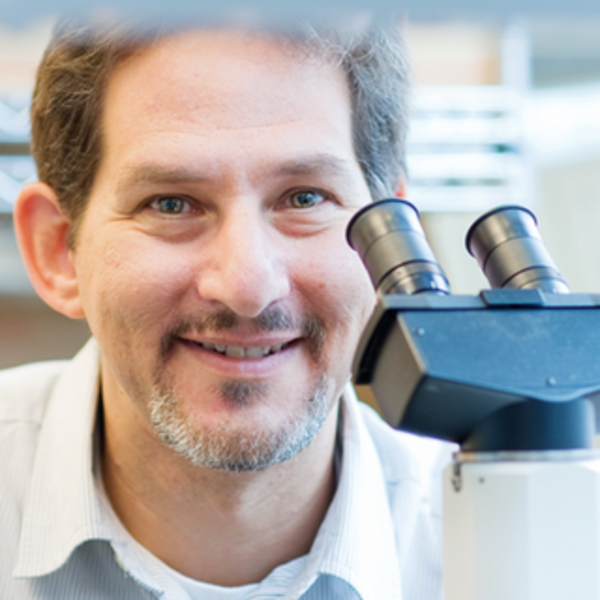Stuart Berger
PhD

The theme of the research in my laboratory is to understand how signaling events result in important biological endpoints such as growth, differentiation and cell activation. The cellular models on which we focus for these studies are mast cells, factor-dependent and independent leukemia cells and breast cancer.
We are currently pursuing the following investigations:
1) Activation Enhanced Cell Death
Cell death mechanism developed and characterized by us that involves induction of ER stress through the depletion of intracellular Ca2+ stores. Recent advances include the characterization of how the imidazole Econazole (Ec) induces AECD. We demonstrated that Ec depletes the ER of Ca2+by blocking Ca2+ influx and stimulating ER Ca2+ release directly through the generation of mitochondrial ROS (Zhang et al. 2006). Recently, we have demonstrated that c-myc sensitizes cells to Ec by regulating Ec's ability to generate mitochondrial ROS (Yu et al. 2008). Translational work with this compound includes the generation of a unique liposomal formulation of Ec using a novel method of drug encapsulation called Micelle Transfer (Cogswell et al. 2006). We also showed that liposomal Ec is well tolerated in mice and has anti-tumor activity using human breast cancer (Cogswell et al. 2006) and lung cancer xenografts and a mouse model of metastatic breast cancer.
2) Fibroblast-like synoviocytes in Rheumatoid Arthritis
Rheumatoid Arthritis (RA) is a chronic inflammatory disease causing progressive joint destruction, deformity and disability. In RA, the joint space fills up with cells of the immune system. These cells stimulate increases in a cell type called fibroblast-like synoviocytes or FLS. FLS are found in normal joints however they are dramatically increased in number and activated in RA. FLS contribute to joint damage by stimulating immune cells and releasing cartilage-damaging enzymes. In RA, FLS expand in number, in part, due to resistance to a normal process of cell death. We have shown that statins, drugs that are commonly used to treat hyperlipidemia, can reverse the resistance of the FLS to cell death and ‘normalize’ the response of these cells (Connor et al.2006). Our studies indicate that statins target intracellular signaling pathways that are stimulated by the cytokine TNF-a. These observations suggest that if statins are delivered appropriately in arthritic joints, they will not only exert anti-inflammatory actions but may also act as disease modifying agents with the potential for preventing joint damage caused by activated synovial fibroblasts. Current work is directed towards better understanding the mechanism of action of statins in RA and in developing appropriate drug delivery and therapeutic strategies for treating RA with statins.
3) Calpain and calpastatin in cancer
Calpains are intracellular cysteine proteases implicated in a wide variety of biological processes. We have shown that calpain inhibition preferentially induces apoptosis in leukemia and lymphoma cells. We have implicated the proto-oncogene c-myc in this effect, showing that c-myc regulates calpain activity by regulating the endogenous inhibitor calpastatin (Niapour et al.; in the press). Current work is directed towards expanding this work in additional experimental and clinical models.
Other interests: Ca2+ signaling in mast cells, role of oxidases in colon cancer, therapeutic potential of statins in cancer.
Recent Publications
- Zhang, Y. & Berger, S.A. (2003) Ketotifen reverses P-glycoprotein-dependent multi-drug resistance and protects against doxorubicin cardiotoxicity. Cancer Chemotherapy and Pharmacology 51: 407-14.
- Trieselmann, N.K., Soboloff, J. & Berger, S.A. (2003) Mast cells stimulated by membrane-bound, but not soluble, Steel Factor are dependent on Phospholipase C activation. Cellular and Molecular Life Sciences. 60: 759-66.
- Zhang, Y., Berger, S.A. (2004) Increased calcium influx and ribosomal content correlate with resistance to endoplasmic reticulum stress-induced cell death in mutant leukemia cell lines. Journal of Biological Chemistry 279: 6507-16.
- Cheuk, A.T.C., Chan, L., Czepulkowski, B., Berger, S.A., Yagita, H., Okumura, K., Farzaneh, F., Mufti, G.J. & Guinn, B.A. (2006) Development of a whole cell vaccine for acute myeloid leukaemia. Cancer Immunology, Immunotherapy, 55, 68-75.
- Berger, S.A. (2006) Signaling Pathways Influencing SLF and c-Kit-Mediated Survival and Proliferation. Immunol. Res. 35:1-11.
- Connor, A., Berger, S., Narendran, A. & Keystone, E.C. (2006) Inhibition of Protein Geranylgeranylation Induces Apoptosis in Synovial Fibroblasts. Arthritis Research and Treatment 8:R94.
- Cogswell, S., Berger, S.A., Waterhouse, D., Bally, M.B., & Wasan, E.K. (2006) A parenteral econazole formulation using a novel micelle-to-liposome transfer method: in vitro characterization and tumor growth delay in a breast cancer xenograft model. Pharmaceutical Res. 23:2575-85.
- Zhang, Y., Soboloff, J., Zhu, Z. & Berger, S.A. (2006) Inhibition of Ca2+ Influx Is Required for Mitochondrial Reactive Oxygen Species-Induced Endoplasmic Reticulum Ca2+ Depletion and Cell Death in Leukemia Cells. Mol. Pharmacol. 70:1424-34.
- Niapour, M. & Berger, S.A. (2007) Flow Cytometric measurement of calpain activity in living cells. Cytometry 71A:475-85.
- Bogoch, E.R., Lee, T.C., Fornasier, V.L. & Berger, S.A. (2007) Articular damage is associated with intraosseous inflammation in the subchondral bone marrow of joints affected by experimental inflammatory arthritis and is modified by zoledronate treatment J. Rheumatol. 34: 1229-40.
- Yu, Y., Niapour, M., Zhang, Y.,& Berger, S.A. (2008) Mitochondrial regulation by c-Myc and HIF-1 controls sensitivity to Econazole. Molecular Cancer Therapeutics 7: 483-91.
- Nepal, R.M., Zaheen, A, Basit, W., Li, J., Berger, S.A. & Martin, A. Lymphomagenesis in Eμ c-myc transgenic mice is not impacted by RAG1 or AID. Oncogene (in the press)
- Niapour, M., Yu, Y., & Berger, S.A. Regulation of calpain activity by c-myc through calpastatin and promotion of transformation in c-myc-negative cells by calpastatin suppression. J. Biol. Chem. (in the press).
